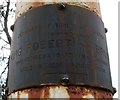This flagstaff, near
Image, was erected in 1928 to honour King Robert the Bruce. See
Image for the top of it.
The name Castle Hill, and the presence of a mound which, at that time, was thought to be the remnant of a once fortified site, suggested that it was the probable location of the residence at which the king had spent much time in his later years (see
Image for another view of that hill). The 1928 flagstaff was erected by the Dumbarton Patriotic Association; their plaque on the flagstaff is shown in
Image, and promoted the idea that the king had lived at Castle Hill.
[The present photograph was taken from Glencairn Road. The main road running from left to right across the image, behind the flagstaff, is Cardross Road; from that road, Castlehill Road leads uphill. The area on the near side of Cardross Road is now called Brucehill, and the area on the far side of the road is called Castlehill. However, the "Castle Hill" referred to above is the actual hill of that name, which is at
Image, hidden away in the wooded north-eastern corner of what is now the
Image]
[As an aside, the nearby Oxhill area is named after Oxen Hill, "a small arable hill on the farm of Braehead"; the hill and farm are shown on the first-edition OS map, and the quote is from the OS Object Name Books.]
Although current thinking would place Bruce's house elsewhere (as discussed at length in the article linked from the end-note), the flagstaff remains a fitting symbol of Robert the Bruce's historical associations with the wider area.
By late 2018, the flagstaff had been replaced by a new one:
Image /
Image The symbolic weather vane remained:
Image The plaque, since its text applies only to the *original* flagstaff, is no longer present.
The article in the end-note also has more information about the flagstaff itself.











